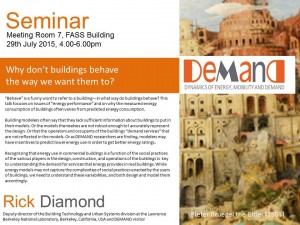 “Behave” is a funny word to refer to a building—in what way do buildings behave? For the particular question posed by the title, the reference is to “energy performance” and in this specific instance, the issue of why does the measured energy consumption of the building vary from the predicted energy consumption?
“Behave” is a funny word to refer to a building—in what way do buildings behave? For the particular question posed by the title, the reference is to “energy performance” and in this specific instance, the issue of why does the measured energy consumption of the building vary from the predicted energy consumption?
Building modelers often say that they lack sufficient information about the buildings to put in their models. Or the models themselves are not robust enough to model accurately the designs. Or perhaps the operators and occupants of the buildings “demand services” that are not reflected in the models. Or as work by DEMAND reserchers are finding, modelers may have incentives to predict lower energy use in order to get better energy ratings.
Recognizing that energy use in commercial buildings is a function of the social practices of the various players in the design, construction, and operations of the buildings is a key insight to understanding the demand for services that energy provides in real buildings. While energy models may not capture the complexities of social practices exhibited by the users of buildings, we need to understand these variabilities, and both design and model them accordingly.
Rick Diamond was a Visiting Researcher, DEMAND Centre at Lancaster University between June-July 2015. He is a staff scientist, and deputy director of the Building Technology and Urban Systems division at the Lawrence Berkeley National Laboratory, Berkeley, California, USA.
MR7 FASS Building, Lancaster University, 29 July 2015

